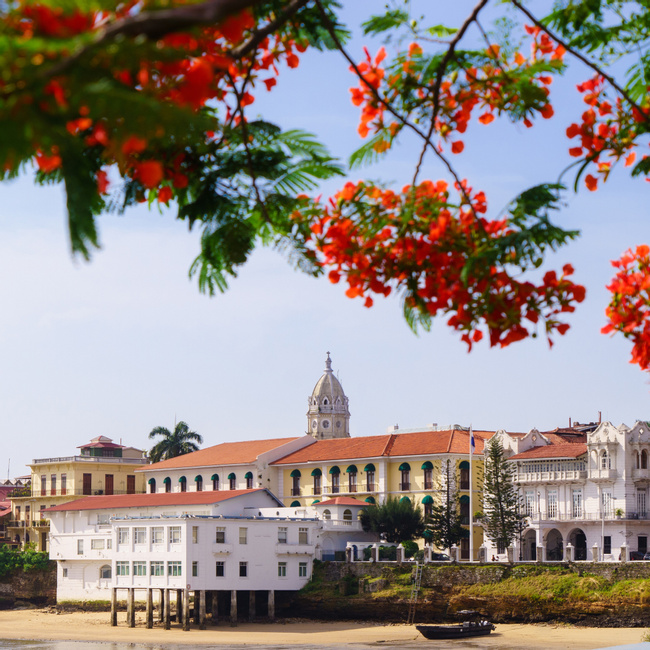- Travel Guides
Music and Art in Panama
Panama has a rich tradition in the arts. Many of the country’s folkloric traditions come from the central region, in particular the Azuero Peninsula. The Azuero Peninsula is known affectionately as Panama’s heartland and it is from here that some of the best-known styles of music and dance originate.


Music and Art
The accordion is one of the most important instruments in Panamanian folk music. Other notable instruments include la mejoranera (a five-stringed guitar), la bocana (a four-stringed guitar), los tambores (wooden drums), and la guáchara (an instrument played by running a stick across carved notches). Singing can accompany folk music and will sometimes include a type of singing known as the saloma, which is similar to yodeling. Panamanian folk music has evolved over the years and is today mixed with modern styles. Known as música típica, this music often combines traditional elements (accordions and yodeling, for example) with upbeat rhythms and pop-like structures. Its most famous musicians include Ulpiano Vergara, an accordionist, and the sibling-duo Samy and Sandra Sandoval.
You’ll likely hear some reggaeton while traveling in Panama. Many people trace the genre’s roots to Panama, but most of its current stars hail from Puerto Rico. Reggaeton’s driving rhythm, rap-like lyrics, and dancehall sensibility has made it extremely popular across much of Latin America. Some of reggaeton’s forefathers, including El General and Nando Boom, were from Panama and were highly influential in the early 1990s.
Panama also has a big rock scene. Bands such as Los Rabanes, who sing in both English and Spanish, have gained international audiences. Other notable Panamanian rock bands include Cage9, Los 33, Polyphase, and Son Miserables. Jazz and classical concerts are also performed in Panama City and are attended mainly by the urban upper class.
Ruben Blades is without a doubt the most popular Panamanian musician outside the country. A salsa star, Blades gained fame by working with Willie Colón and then went solo. He’s also acted in movies and is currently the director minister of tourism for Panama.
If you hear live folk music in Panama, chances are it will be accompanied by dancing. The most famous dance is el tamborito. As its name implies (tambor means drum in Spanish), this dance is rhythmic and drum-based. Women dress in polleras (hand-embroidered dresses), while the men wear either embroidered shirts and cut off pants or long-sleeved white shirts and black pants. Men will also usually wear a sombrero pintado, a traditional painted hat. Other folkloric dances include the mejorana, the congos (a dance derived from Africa), and the balsería, which is performed by the indigenous Ngöble-Buglé and involves balsa poles being thrown at participants’ legs.
You can also expect to hear a variety of music at Panamanian festival and holiday celebrations — especially during Carnaval. For a truly unique sound, be sure to explore the country's religious music.
Panama has seen a number of notable painters. Guillermo Trujillo (b. 1927) and Alfredo Sinclair (b. 1915) are considered two of the best and their work has been shown in galleries across the world. Roberto Lewis (1874-1949) is another well-known Panamanian painter who is best known for his large murals and paintings of Isla Taboga, an island close to Panama City. His work often mixes history with mythology and is still found today in the Teatro Nacional and presidential palace.
Younger painters include Brooke Alfaro (b. 1949), whose paintings focus on the marginalized members of Panamanian society, and Isabel de Obaldía (b. 1957), a woman known for both her painting and glasswork. Sheila Lichacz (b. 1942) is a Panamanian artist whose work was exhibited at the Smithsonian in Washington, D.C. in 2003. Her subjects are frequently the tinajas (clay pots) that date back to pre-Columbian times and are famous throughout Panama.
Panama’s indigenous groups also produce a prodigious amount of fine art. These are usually sold as souvenirs and include cocobolo statues and carved tagua nuts. Some indigenous art has achieved international fame, in particular the molas (handcrafted blouses) made by the Guna and woven baskets of the Emberá-Wounaan.
Panamanian literature has had a hard time making it outside of the country. Its themes tend to center around the national identity and history of Panama, and are often in the form of short stories or poetry.
Ricardo Miró (1883-1940) is Panama’s best-loved poet. Known as “El Poeta de Panamá,” Miró produced mainly poems and short stories, and is the name behind the country’s most important literary awards. Another important literary figure was Rogelio Sinán (1902-1994), who wrote novels, short stories, poetry, and plays. Contemporary authors include Enrique Jaramillo Levi (b. 1944), Ernesto Endara (b. 1932) and Rosa María Britton (b. 1936). Plays are frequently performed in Panama City and some are even offered in English.
We believe travel is more than ticking destinations off a list – it’s about discovering new places deeply, feeling connected wherever you go, and knowing you have a trusted team behind you every step of the way.



